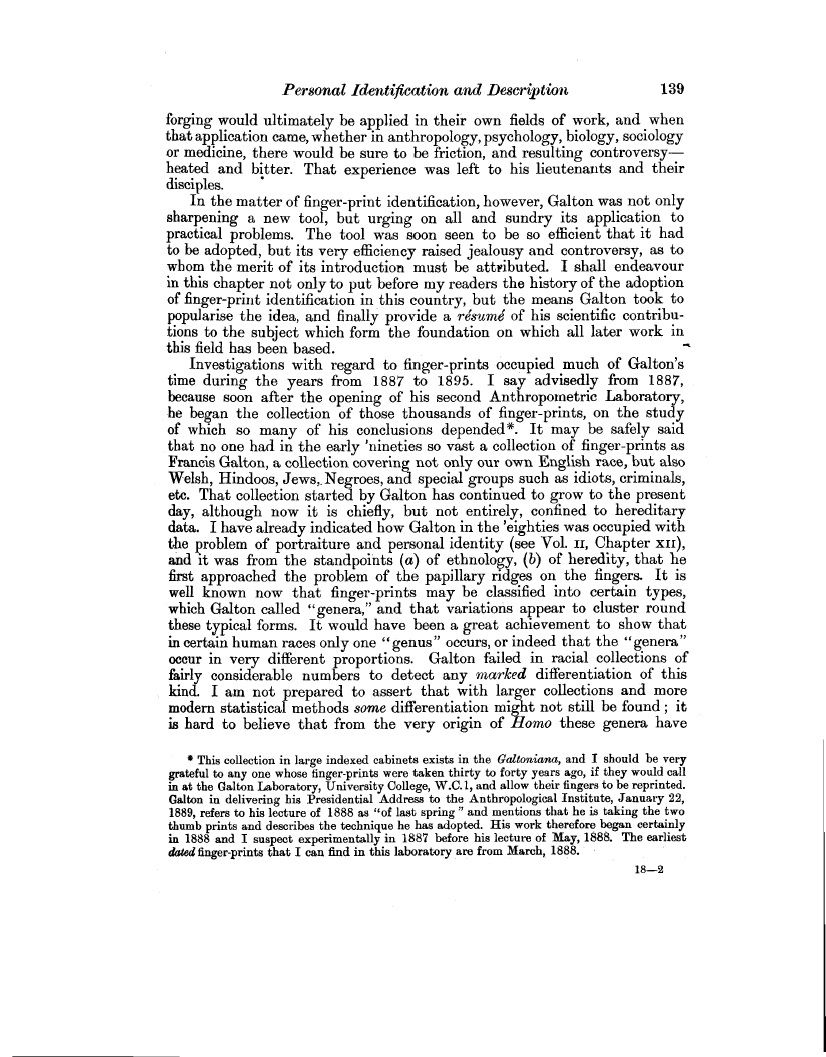| ||||||

OCR Rendition - approximate
Personal Identification and Description 139 forging would ultimately be applied in their own fields of work, and when that application came, whether in anthropology, psychology, biology, sociology or medicine, there would be sure to be friction, and resulting controversyheated and bitter. That experience was left to his lieutenants and their disciples. In the matter of finger-print identification, however, Galton was not only sharpening a new tool, but urging on all and sundry its application to practical problems. The tool was soon seen to be so efficient that it had to be adopted, but its very efficiency raised jealousy and controversy, as to whom the merit of its introduction must be attributed. I shall endeavour in this chapter not only to put before my readers the history of the adoption of finger-print identification in this country, but the means Galton took to popularise the idea, and finally provide a resume of his scientific contributions to the subject which form the foundation on which all later work in this field has been based. "~ Investigations with regard to finger-prints occupied much of Galton's time during the years from 1887 to 1895. I say advisedly from 1887, because soon after the opening of his second Anthropometric Laboratory, he began the collection of those thousands of finger-prints, on the study of which so many of his conclusions depended*. It may be safely said that no one had in the early 'nineties so vast a collection of finger-prints as Francis Galton, a collection covering not only our own English race, but also Welsh, Hindoos, Jews,. Negroes, and special groups such as idiots, criminals, etc. That collection started by Galton has continued to grow to the present day, although now it is chiefly, but not entirely, confined to hereditary data. I have already indicated how Galton in the 'eighties was occupied with the problem of portraiture and personal identity (see Vol. ii, Chapter x11), and it was from the standpoints (a) of ethnology, (b) of heredity, that he first approached the problem of the papillary ridges on the fingers. It is well known now that finger-prints may be classified into certain types, which Galton called "genera," and that variations appear to cluster round these typical forms. It would have been a great achievement to show that in certain human races only one "genus" occurs, or indeed that the "genera" occur in very different proportions. Galton failed in racial collections of fairly considerable numbers to detect any marked differentiation of this kind. I am not prepared to assert that with larger collections and more modern statistical methods some differentiation might not still be found ; it is hard to believe that from the very origin of Homo these genera have * This collection in large indexed cabinets exists in the Galtoniana, and I should be very grateful to any one whose finger-prints were taken thirty to forty years ago, if they would call in at the Galton Laboratory, University College, W.C. 1, and allow their fingers to be reprinted. Galton in delivering his Presidential Address to the Anthropological Institute, January 22, 1889, refers to his lecture of 1888 as "of last spring " and mentions that he is taking the two thumb prints and describes the technique he has adopted. His work therefore began certainly in 1888 and I suspect experimentally in 1887 before his lecture of May, 1888. The earliest dated finger-prints that I can find in this laboratory are from March, 1888. 18-2
|